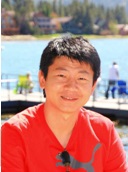题目:Photonic time stretch: linking space, spectrum and time towards microwave photonics applications
时间:2017.10.27(星期五)上午10:30
地点:无线谷A1号楼1319会议室
演讲人:Dr Chao Wang (Senior Lecturer in Electronic Systems, University of Kent, UK)
时空频谱三位一体:光子时域拉伸技术在微波光子系统中的应用(Photonic time stretch: linking space, spectrum and time towards microwave photonics applications)
Dr Chao Wang (Senior Lecturer in Electronic Systems, University of Kent, UK)
 Abstract:Photonic time stretch (PTS) technique maps the broadband spectrum of an ultrashort optical pulse into a time stretched waveform using chromatic dispersion. Owing to its capability of real-time pulse-by-pulse spectroscopic measurement and manipulation, PTS has become a promising technique for ultrafast signal generation and processing, and high-throughput real-time measurement in optical communications, optical sensing, spectroscopy and imaging, where the speed of traditional optical instruments falls short. In this talk, emerging interdisciplinary field of microwave photonics is first briefly introduced. The principle and implementation methods of PTS are then introduced and the recent development in employing PTS technique for widespread microwave photonics applications are presented, with emphasis on real-time spectroscopy, arbitrary waveform generation, microwave spectrum sensing, ultrafast optical imaging and optical wireless communication. Current challenges and possible future research directions for PTS-based microwave photonics techniques will be discussed as well.
Abstract:Photonic time stretch (PTS) technique maps the broadband spectrum of an ultrashort optical pulse into a time stretched waveform using chromatic dispersion. Owing to its capability of real-time pulse-by-pulse spectroscopic measurement and manipulation, PTS has become a promising technique for ultrafast signal generation and processing, and high-throughput real-time measurement in optical communications, optical sensing, spectroscopy and imaging, where the speed of traditional optical instruments falls short. In this talk, emerging interdisciplinary field of microwave photonics is first briefly introduced. The principle and implementation methods of PTS are then introduced and the recent development in employing PTS technique for widespread microwave photonics applications are presented, with emphasis on real-time spectroscopy, arbitrary waveform generation, microwave spectrum sensing, ultrafast optical imaging and optical wireless communication. Current challenges and possible future research directions for PTS-based microwave photonics techniques will be discussed as well.
Biography: Dr Chao Wang received the B.Eng. degree in Optoelectrical Engineering from Tianjin University, China, in 2002, the M.Sc. degree in Optics from Nankai University, China, in 2005, and the Ph.D. degree in Electrical and Computer Engineering from the University of Ottawa, Canada, in 2011. From 2011 to 2012, he was a NSERC Postdoctoral Fellow at the University of California, Los Angeles (UCLA), USA. In 2013, he was appointed as a Lecturer at the School of Engineering and Digital Arts, University of Kent, U.K., where he is currently a Senior Lecturer.
Dr Wang’s research interests lie in interdisciplinary areas that study the interaction between photonics and other state-of-the-art technologies in different fields, such as microwave photonics, biophotonics, ultrafast optical imaging, optical communications, and optical sensing. His research activities have been well funded by EU Marie-Curie Actions, the Royal Society of UK, University of Kent, and Natural Sciences and Engineering Research Council (NSERC) of Canada. He has authored over 90 peer-reviewed journal publications and conference papers, with a h-index of 21. He has given many invited or post-deadline talks in major photonics conferences including ECOC, MWP, FiO, and IPC. He was the recipient of SPIE Scholarship in Optical Science and Engineering (2008), Vanier Canada Graduate Scholarship (2009), Chinese Government Award for Outstanding Self-Financed Students Abroad (2009), IEEE Photonics Society Graduate Student Fellowship (2009), IEEE Microwave Theory and Techniques Society Graduate Fellowship (2010), NSERC Postdoctoral Fellowship (2011), and EU Marie Curie Career Integration Award (2014). He also received the Best Paper Awards from APMP 2009 and MWP 2010.
He is serving as an active reviewer of more than 20 leading photonics journals of OSA, IEEE, Nature, IET, Elsevier and Wiley. He served as the Co-organizers of symposiums in PIERS 2014 and CLEO-PR 2017.He also served as a TPC member for photonics conferences including Photonics Asia 2014-2016, PIERS 2014, ACP 2015, ICOCN 2015-2017, OECC 2015, Photonics West BiOS 2016-2018, OMTA 2016, APOS 2016, CLEO-PR/OECC/PGC 2017, OIT 2017 and MWP 2017, and as of the Guest Editor of Special Issue on Microwave Photonics in SPIE Optical Engineering (2014) and MDPI Photonics (2017).

